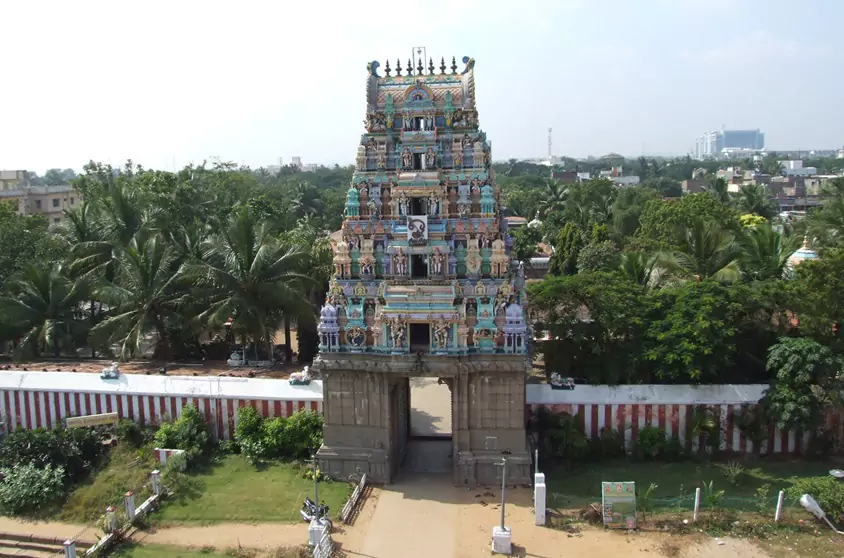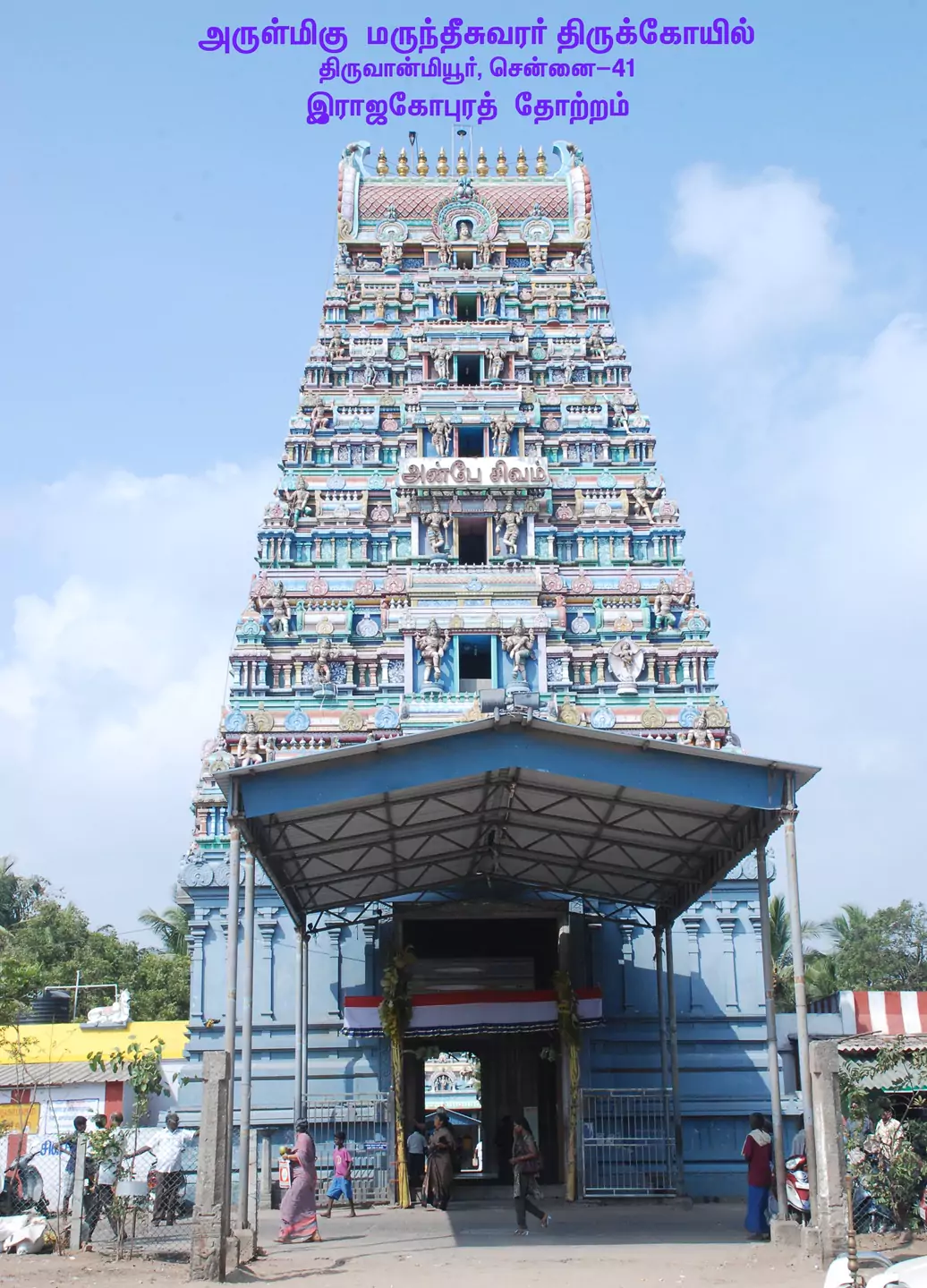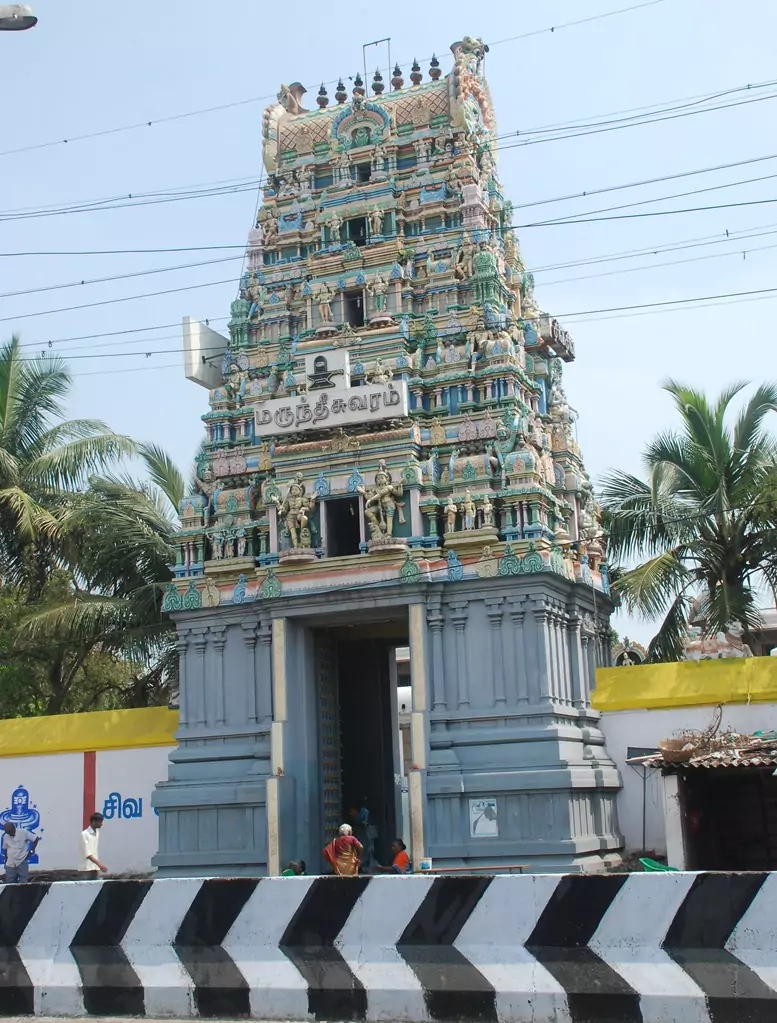- July 22, 2025

| Shiva Sthala | Thiruvanmiyur Marundheeswarar Temple |
|---|---|
| Moolavar | Marundeeswarar, Palvannanathar |
| Utsavar | Thiyagarajar |
| Amman | Tripura Sundari, Sokka Nayagi |
| Theertham | Pancha Theertham |
| Agamas | Kāmika |
| Sthala Viruksham | Jand [Vanni Tree] |
| Purana Name | Thiruvanmigiyur |
| Town/Village | Thiruvanmiyur |
| District | Chennai |
Thennādudaiya Sivanē Pōtri
Ennāttavarkkum Iraivā Pōtri

Nestled along the scenic coastline of Chennai, Tamil Nadu, the Arulmigu Marundeeswarar Temple in Thiruvanmiyur stands as a beacon of spiritual solace and divine grace. Revered as the 25th of the 276 Paadal Petra Sthalams (sacred Shiva temples glorified by the Tevaram hymns) in the Tondai Nadu region, this temple is a treasure trove of mythological significance, architectural grandeur, and spiritual vibrancy. Dedicated to Lord Shiva as Marundeeswarar (the Lord of Healing) and Goddess Parvati as Thiripurasundari, this sacred site draws devotees seeking both physical and spiritual rejuvenation. Located along the coastline of Chennai, Thiruvanmiyur stands as a prominent sacred site among the revered temples of Mylapore, Thiruvallikeni, and Thiruvotriyur.
The name Thiruvanmiyur traces its origins to Sage Valmiki, also known as Vanmiki, who attained salvation here through fervent worship of Lord Shiva. Legend has it that during the full moon day of the Tamil month Panguni, Valmiki was blessed with a divine vision of Lord Shiva’s cosmic dance, granting him mukthi (liberation). This divine event earned the temple its name, Vanmiyur or Thiruvanmiyur.
Sage Agastya, another revered figure, was graced with a divine vision of Lord Shiva and Parvati in their wedding form at this temple. Lord Shiva also imparted to Agastya the sacred knowledge of medicinal herbs, earning the deity the title Marundeeswarar (Lord of Medicines) or Oushadeeswarar. Additionally, the celestial cow Kamadhenu, seeking liberation from a curse by Sage Vashishta, performed milk abhishekam (ritual bathing) on the self-manifested (Suyambu) Lingam here. This act turned the Lingam a radiant white, giving Lord Shiva the name Palvannanathar (Lord of Milky Hue). The hoof marks of Kamadhenu are still visible on the Lingam, adding to its sanctity.
In a remarkable incident, devotee Appaya Dikshitar, unable to cross a flood to reach the temple, prayed fervently to Lord Shiva. In response, the Lord turned westward to grant him a divine vision, making this temple unique as its sanctum faces west, unlike the traditional eastward orientation.
Other sacred sites where Sage Agastya witnessed Lord Shiva’s divine wedding form include Kutralam, Thiruppangadu, Thirukkallil, Thiruvotriyur, and Thiruverkadu.

The Marundeeswarar Temple is a masterpiece of Dravidian architecture, featuring a majestic seven-tiered Rajagopuram (main tower) in the east and a five-tiered gopuram in the west. The sanctum houses the Suyambu Lingam of Lord Marundeeswarar, facing west, while Goddess Thiripurasundari’s shrine faces south. The temple’s outer courtyard (prakaram) is adorned with shrines for Lord Vinayaka, Lord Muruga, the Nayanmars (Saivite saints), 108 Shivalingams, and the Pancha Lingams. The Goshta Murthams (deities on the sanctum walls) include Brahma, Durga, Mahavishnu, and Dakshinamurthy, exuding divine elegance.
The sacred Vanni tree, located in the northwest corner, is the temple’s Sthala Vriksham (sacred tree). It is believed that Lord Shiva appeared under this tree to grant visions to both Agastya and Valmiki. A dedicated shrine for Sage Valmiki further enhances the temple’s spiritual aura.
The temple bears inscriptions from the Chola dynasty, including those of Rajendra Chola and Rajadhiraja, documenting endowments such as land, gold, and provisions for perpetual lamps and garlands, underscoring its historical prominence.
The Panguni Brahmotsavam, a grand festival held in the Tamil month of Panguni (March-April), is the temple’s highlight. Key events include the Pavani Utsavam on the third and fourth days, the Vanni Tree Seva on the ninth day, Lord Thyagaraja’s divine wedding dance on the tenth day, and the Velliyangiri Vimana Seva on the eleventh day. As the Sun is believed to have worshipped Lord Shiva here at midnight, the flag-hoisting ceremony during the festival takes place at Arthajamam (midnight).
Daily rituals begin with Gopuja (cow worship), followed by milk abhishekam for the Suyambu Lingam. Other offerings, such as Panchamritham, are performed only on the Avudaiyar (base of the Lingam), preserving the sanctity of the self-manifested deity.
The temple is glorified by the Tevaram hymns of saints Thirugnanasambandar, Thirunavukkarasar (Appar), and Arunagirinathar. A verse by Thirunavukkarasar captures the divine essence:
Clearing the mind of delusion and darkness,
Seeking the Lord who resides in pure hearts,
If you can praise my Lord Shiva with devotion,
The Lord of Vanmiyur will come to you.
Devotees believe that performing milk abhishekam to Lord Marundeeswarar and partaking of the Vibhuti (sacred ash) prasad can cure chronic ailments and absolve sins. Circumambulating the sacred Vanni tree is said to grant liberation (mukthi). Offering new garments to Lord Shiva and Goddess Thiripurasundari is a popular vow (nerthikadan) among devotees.
The Marundeeswarar Temple is located in the southern part of Chennai, along the East Coast Road, approximately half a kilometer from the Thiruvanmiyur bus terminus. The temple is easily accessible by Chennai’s extensive bus network, connecting it to other parts of the city.
Arulmigu Marundeeswarar Temple,
8, West Tank Street,
Thiruvanmiyur, Chennai,
Tamil Nadu – 600041
Thiruvanmiyur Temple Contact Number: +91-44-2441 0477
The Marundeeswarar Temple in Thiruvanmiyur is a divine confluence of spirituality, healing, and architectural splendor. It offers devotees a sacred space to seek physical wellness, mental peace, and spiritual elevation. A visit to this revered temple is a must for anyone in Chennai, promising an experience of divine grace and eternal renewal.